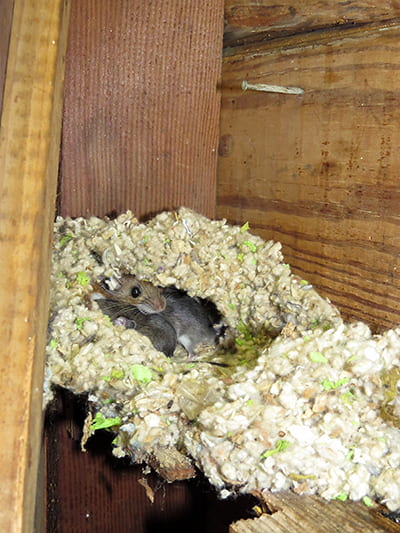Birds and Berries and Bugs, Oh My!

(Above) Hummingbirds can capture insects out of thin air, a practice known as hummingbird hawking. We found that this carnivorous habit may actually be reducing SWD numbers in berry plantings. While growers consider the option of ‘employing’ these partners in IPM, gardeners and homeowners can also encourage hummingbird visits by choosing nectar-rich flowers and shrubs for their property. As the emphasis for pollinator protection grows, we all benefit from partnering with our many, often-ignored, beneficial allies, like hummingbirds.
Like all fruit flies, the spotted wing drosophila (SWD) loves berries. But, unlike other fruit flies that wait for fruit to rot and split, SWD females lay their eggs inside perfect, ripening fruit. The eggs hatch into tiny white worms—a nasty surprise, decimating a crop’s market value. What’s a berry farmer to do? Spraying pesticides—especially on U-Pick farms where families mingle with plants—isn’t their preferred plan.
Enter the ruby-throated hummingbird, New York’s resident species. Not just a fan of nectar, they also eat gnats, fruit flies, and aphids—gobbling up to 2,000 a day. When we learned a blackberry farmer in Mississippi had success against SWD by attracting hummingbirds into fields, we wondered … could it work in New York?
To find out, we set up 25 hummingbird feeders per acre in two raspberry fields. We observed hummingbird presence and flight patterns, examined SWD traps, and checked berries for infestation over a four-year period. We found that 80 percent of the birds visiting feeders also spent time in the raspberries; traps caught up to 59 percent fewer SWDs; and every week during peak hummingbird season, up to 56 percent fewer worms were found in fruit.
Our results suggest that hummingbirds reduced SWD fruit damage. We always found more hummers in our raspberry plots over time, because they return each spring to familiar feeding grounds. Studies of feeding habits have shown they try eating new things and remember what they like. So let’s cultivate a voracious appetite for SWD in the ruby-throated hummingbird by attracting them into our berry plantings!
Location, Location, Location
Each year, rodents cause billions of dollars in losses to the food supply. Theirs is a one-two punch: they both eat and contaminate food. And because rodents can carry dozens of pathogens harmful to people and animals, the stakes are high. In the U.S., new laws require that food facilities take proactive steps to prevent rodent problems.

(above) Who can blame her? Momma mouse loves the food, water, and warmth often found in food processing and distribution facilities. IPM tactics greatly reduce rodent numbers and protect our food supply in commercial facilities as well as in our homes.
With the food industry in mind, we designed a research project to understand and improve rodent management in food distribution centers. The goal? Figure out whether the location of trap and bait boxes affects our ability to intercept rodents. The current industry standard is to place rodent devices at regular intervals inside and outside the building, but this doesn’t take into account what rodents like, what they need, and how they move. Is there a better way?
For several years our NYSIPM rodent expert inspected the areas around rodent traps and bait boxes, and recorded features that are attractive to rodents like available food, water, shelter, and warmth. He found that instead of old-school placement, traps worked better when positioned near preferred features. Our results can improve IPM protocols—that means less food contamination, less rodenticide, and less time required by pest professionals for device inspection. With this new IPM info, we don’t need to build better mousetraps, we just need to know where to put them.

(Above) This door may not look welcoming to you, but for rats and mice the gap under the door signals a source of food and shelter. Nearby, there is soil, dense vegetation, railroad tracks … all things that help rodents hide, burrow, and thrive. Our study confirmed that these elements increased feeding at bait stations (shown inside white circle), which could change the way professionals lay out bait stations in the future.